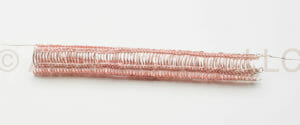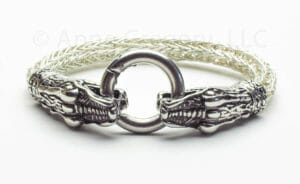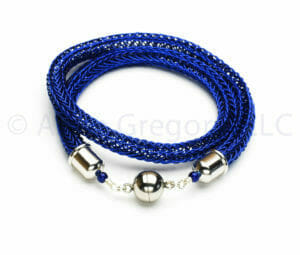
Trichinopoly Viking Knit
Since my last post, I have learned a new and exciting weaving technique which serves to broaden my educational journey in jewelry fine arts; it’s called Viking Knit, or Trichinopoly Chainwork.
As the name would imply, Viking Knit or, circular knitting, was an art form practiced by the Norse in the 8th and 9th centuries to create jewelry and clothing articles from both metal wire and cloth fibers. The objects they created were used for utilitarian purposes and self-adornment but it was mercantile interests that helped fuel production.
Archeological digs (Anglo-Saxon Norse, Byzantine, Greek and Roman) have unearthed artifact hoards from as far back as the 1st century B.C.E. An 8th-9th century silver paten (plate) was unearthed (along with 4 other metalwork pieces, including the famous Derrynaflan Chalice) at the site of what was once an early Irish abbey near Killenaule, County Tipperary, Ireland. The rim of this ancient vessel contains lovely Trichinopoly chainwork. Photos and additional information can be found at the following reference derived from James Graham-Campbell‘s book called, The Viking-age Gold and Silver of Scotland (AD 850-1100):
The Viking-age Gold and Silver of Scotland (AD 850-1100)
Viking Knit jewelry has been excavated from the burial sites of both men and women. Dress and hair pins were frequently found along side female skeletons, while neck chains carrying pendants depicting Norse nomenclature (axe head, Thor’s Hammer, etc.) were found in gravesite’s containing male bones. Today’s Viking Knit jewelry is more gender-neutral.
I began the hook and loop-type weave using a 36-inch length of wire and an existing wood dowel. But in my travels around the internet, I happened to come across a plastic gadget that was reported to be the latest and greatest for wire weaving, I purchased the Lazee Daizee (patent pending by Stephanie Eddy) and went to work creating wire rope in varying colors. I still wasn’t sure I had hit on the best apparatus for weaving so I went back to the web and found another gizmo called Viking Knit Tool that was being used by a few good artisans. It, too, was a long, round wood dowel but with a plastic laminated exterior (patent pending by Barbara Gumeson) and, to my surprise, it is now my go-to rod of choice.
There are many fabulous people around the world creating Viking Knit Jewelry. Irene From Peterson wrote a wonderful book called, Great Wire Jewelry. It got me from A to Z with the weaving technique. Lora-Lynn Stevens has an excellent research paper on Trichinopoly Chainwork. And British artist, Abbey Hook, sells a brilliant tutorial on Etsy called “Viking Knit Chain”. It was her instructions on “how to add new wire” that allowed me to step up to the level required to begin selling my Viking jewelry. Here are some links if you’re interested:
Irene From Peterson: Great Wire Jewelry
Lora-Lynn Stevens: Trichinopoly Chainwork
Abby Hook: Viking Knit Chain Tutorial
Barbara Gumeson: Viking Knit Tool
With so many good artists creating and selling fabulous Viking Knit Jewelry, I wondered whether they switched (like I had, initially) from using a wood dowel to some new-fangled contraption like the Lazee Daizee (which I found to be pricey and more gimmicky than practical). They had not. In fact, to a person, the wood dowel was the rod of choice.
Here are a few photos to enjoy:




